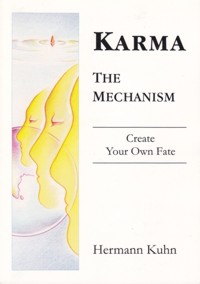
Asravanirodhah samvarah (1)
New karma acts like 'fuel'. It renews the energy that forces our 'karmic engine' on and on.
Once we stop the intake of new karma, the karmic process loses the main source of energy that keeps it in motion. Though our 'karmic engine' may continue to run for a while longer since its remaining energy still needs to manifest till it is fully dissolved, we already initiated the ultimate end of the 'journey'.
The beginning of this process will be noticed clearly. While riding in an automobile, we sense immediately when the accelerator is not pressed down any more, even though the car continues to roll. With similar clarity we sense our life take a new course as soon as we stop fuelling the karmic mechanisms that limit us.
We can easily identify the effects of this process: - Actions that previously cast an almost hypnotic spell on us, suddenly cease to overshadow our awareness. Equanimity, distance and inner balance increase.[52]
More and more we observe our life simultaneously from two different levels. On one level we still experience the confining narrowness of our old state. Yet at the same time we are watching this confinement from another (higher) level that is characterized by a growing awareness of more expansive dimensions. As this perception deepens, we become able to steer our life more consciously towards further expansion.
The most important - and the simplest - move into this direction is to prevent the acquisition of new karma (samvara). Though this strategy seems far from dissolving our previously bound karma, it is far easier to practice and also generates much faster results.[53] This process takes two steps:
- Step one is our decision to stop all activities that will bind new karma - it is our resolve to end prejudice, intolerance, laziness, skepticism, lack of knowledge, intense negative emotions etc.
- Step two is actually preventing the acquisition of new karmic matter. This happens automatically when we put the decision taken in step one into action.
Splitting this strategy into two steps seems like superfluous exactitude. Yet we only need to realize how often in our life we make highly concrete decisions - and then fail miserably to carry through our resolve. When we - for once - discard the thousand excuses we normally justify these failures with, then we know with dead certainty that a huge gap exists between our decisions and us actually doing what we intended. We only need to remember how often we decided to exercise our body regularly - starting 'tomorrow' - and then tomorrow never came. We only need to recall how many times we were determined to slim down, to stop smoking, to drink less, to learn a new language, to tidy the attic etc. without us ever carrying through with it, to know that it takes far more than just a decision to achieve concrete results.
Only when we realize the immense power our own inertia and laziness hold over us can we assess realistically the enormous energy we need to raise to break this discrepancy between our decisions and action. Fortunately the same mechanism that usually deepens our inertia can also work in our favor: If we get into the habit of always acting on our decisions, it feels natural after a while to raise the additional energy necessary for carrying out our resolves. This also causes our character and willpower to become stronger, more self-assured and reliable.
Apart from recognizing and eliminating the gap between our decision and action, it helps immensely to become aware of the mechanism that creates new karmic attachments.
If we want to prevent new bonds, we need to direct our attention to our very initial attraction to karma (asrava). This is a highly sensitive point: - All initial attraction to karma stimulates us with (new) activity. As long as we feel no emotional reaction to an event, no new karma is bound. At this particular point in time we often can freely decide how to respond to this stimulation. If at this very moment we recall our decision to stop the (beginning of a new) karmic process, and act accordingly, e.g. by consciously following a different (positive) line of thought or to refrain from reinforcing a negative emotional reaction, we attract no new karmic matter. At exactly this time when everything is still open, we have the power to end unwanted karmic processes.[54]
This process is mainly controlled by our emotions. It is therefore highly recommended to direct our attention towards our own emotional reaction to an action instead of only concentrating on the physical event. Many events we confront have no connection to the emotions that shoot through us while we experience them. The events merely trigger our dormant feelings. The more we separate the two components - the physical events and our emotional reactions to it - the more consciously we can control the karmic mechanisms we are involved in.
Since we continuously manifest part of our existing karma - thereby dissolving its attachment to our consciousness - the total amount of karmic molecules in our interactive karmic field inevitably become less once we systematically stop binding new karma.
When we follow this strategy, it usually takes only a short time till we experience first results. Our increasing freedom from events we considered unavoidable before, an independence from persons who held unwelcome power over us etc. are our best motivation to progress further towards full self-determination.
This process works far more efficiently if we observe six simple mechanisms:
Yet these emotions will only last for as long as we dwell on the past. Once we begin to trust that new experiences will always open up after we discarded old levels, our feeling shifts from regret to anticipation and eagerness.
Certainly, it takes energy to take this path, - more energy than just letting us fall into the familiar irritation, - but this is only a small price to pay for freeing our consciousness from an automatic reaction that in the long run will cost us far more energy.
 Hermann Kuhn
Hermann Kuhn
